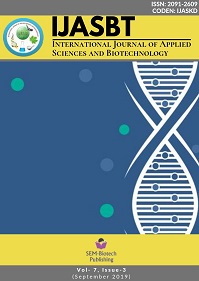Trichoderma and Its Prospects in Agriculture of Nepal: An Overview
DOI:
https://doi.org/10.3126/ijasbt.v7i3.24337Keywords:
Bio-control, Crop plants, Trichoderma sppAbstract
In the world, the traditional agricultural practices are getting affected by various problems such as disease, pest, drought, decreased soil fertility due to use of hazardous chemical pesticides, pollution and global warming. As a result, there is a need for some eco-friendly bio-control agents that help in resolving the previous mentioned problems. The various types of biological control agents such as bacteria and fungi are involved in bio-control activity. Among them, fungal genus Trichoderma plays a major role in controlling the plant diseases. Species of Trichoderma are diverse fungal microbial community known and explored worldwide for their versatilities as biocontrol and growth promoting agents. These fungi reproduce asexually by production of conidia and chlamydospores and in wild habitats by ascospores. Trichoderma species are efficient mycoparasites and prolific producers of secondary metabolites, some of which have clinical importance. However, the ecological or biological significance of this metabolite diversity is sorely lagging behind the chemical significance. Several Trichoderma spp. positively affect plants by stimulating plant growth, and protecting plants from fungal and bacterial pathogens. They are used in biological plant protection as bio-fungicides as well as in bioremediation. A large number of research groups are working on various aspects of Trichoderma viz., diversity, ecology and their applications. The capacity of Trichoderma fungi to produce lytic enzymes is used in animal feed, and wine making and brewery industries. Trichoderma spp. are the most successful bio-control agents as more than 60% of the registered bio-fungicides used in today’s agriculture belongs to Trichoderma -based formulation. The increase in incidence and severity of diseases and emergence of new diseases causes the significant yield losses of different crops in Nepal. But the research and studies on plant diseases are limited.
Int. J. Appl. Sci. Biotechnol. Vol 7(3): 309-316




